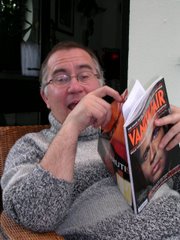Tom Horan is washed away by the music
Video: Fun in the mud at Glastonbury
Audio: Christopher Howse on the magic of Glastonbury
In pictures: Glastonbury 2007
Glastonbury videos, reports, reviews and blogs
Christopher Howse reports from the Glastonbury Festival

Christopher Howse: The only man in a tie among 144,000 revellers
Zac, 11, was pulling Josh, nine, in a sledge, with sloppy Glastonbury mud in place of snow. "Again! Again!" Josh shouted. Then the thunderstorm started.
Away from the mud, with teepees at £1,600 and ridiculously bulky, shiny white camper vans filling the fields, the three-day festival has never been so comfort-seeking.
"In the past eight years I've been here," said the gate steward to the family camping field, "there's more money, less drugs, less crime and no fear of it."
In the first 24 hours, among 144,000 visitors there were only 33 arrests, mostly for drugs.
"And there's less of the hippy thing. Not so much naturism," says a woman volunteer, delicately. "It's the wall that's made the difference," says the steward. The wall is prefabricated, solid and high, disturbingly like Israel's wall.
Michael Eavis, the founder of the festival, is proud of it. "Apparently you can see it from the Moon," he says.
The festival is not at Glastonbury at all, though the cone of the tor breaks the horizon. It is held at Pilton. Perhaps the mystical number of 144,000 here make up a new breed, Pilton Man, which never grows out of a youthful urge to unite ritually each year.
But Clare and David from York, who have "just got our bus passes", are not veterans from the first festival 36 years ago. "We got interested after our children left home," she says. "Dave likes world music, but it's more than that. I like the performance art. It's amazing."
Among the 30,000 cars in the car parks, there are plenty of Audis, Volvos and BMWs. Ten thousand, almost all young, came greenly by train and then chugged the last miles on dirty old buses.
"We're doing a dance degree at Greenwich," says my 20-year-old neighbour, pointing to her fair-haired friend. But now they're spending the weekend working in a vegan cafe, hoping to slip out to see Bjork. Bjork has been here before, she just can't remember.
If for some Glastonbury is joining the social season with Ascot and Henley, its style is still young and grungy. At Henley gentlemen must still wear ties. Here I spent 24 hours without seeing anyone else with one on. Ascot cocktail dresses and feather hats can look vulgar. Here the middle class come in muddy disguise.
The mud was shaping up nicely yesterday - slopping under reckless reinforcements of rain. Nearly 2,000 years ago, an Iron Age tribe built a lake-village near here with huts raised on a solid pile of brushwood clay. This skill has been lost.
Tents in the rain cover the slopes like a swarm of crabs in a nature documentary - their carapaces jostling. The maddest camp next to the giant speakers. Hayley Evans, with her 20-month-old boy, found a quieter family field, behind the open-air cinema. "My baby slept through. But they had Ghostbusters on, and every time there was a scream, I woke up with a jump."
By night the noise and stalls turn the site into an endless funfair. A neon red dragon spews real fire. Chewing on burgers or Mexican veggie wraps, "newgers" or neo-punks mill past Blendavenda (juices and smoothies), Magic Shoes (For Happy Feet), Fairylove (The Place Where the Fairies Get Their Wings). A child cries for a fake tattoo - three scorpions for a pound. "The kids love it," says Miriam Kandis, of north London, as her six-year-old daughter, Bea, grizzles against her sleeve. Well, it was 10.45pm.
The site is so big and the crowds so sluggish that it seems many arrive at the Jazz World stage just in time to miss Toumani Diabate and then slug back to the Dance stage in time to miss Courtney Orange.
The place has its own smell - firelighter smoke, fat from burgers, bacon, Thai food, beer-tent swill, rubbish bins, rubber boots, chemical lavatories. It is not true that Glastonbury is unfashionable dress-wise. Everyone is dressed in a way that would turn heads in the street. Leopardskin wellingtons, a leather kilt and tattoos make a man stand out at home. Not here. Some of the G8 protest tendency can even look frightening in a pixie hat.
A festival-goer dives into the ubiquitous Glastonbury mud, encouraged by a crowd of revellers
A field is given over to disabled camping. A woman in a tricycle wheelchair whizzes downhill towards the Pyramid stage, where Kasabian were to play last night. As a first-timer to Glastonbury, I found it more friendly and more disorientating than I expected. In a way it is an immense babysitting venture. The 144,000 are fed and kept safe. Security men swap radio messages through the night.
Just after dawn at 4am the music abates and a thrush sings. Otherwise nature does not get much of a look-in. Outside the site, honeysuckle smothers a hawthorn, and bramble blossom chokes the ditches. Inside, the grass is trodden into mud. For the locals with houses in the lanes around, this weekend is like August bank holiday for Notting Hillers - noisy and crowded. But at Glastonbury only 13 thefts from tents were reported in the first full day.
"Come back when Mr Eavis's cows are in sole occupancy," says an earnest young man with an interest in the National Youth Orchestra, who perform tomorrow. "You'll be able to see the Four Evangelists carved on the old tithe barn."
Thanks, George, I might just.
Confessions of a Glastonbury virgin Music Arts Telegraph





